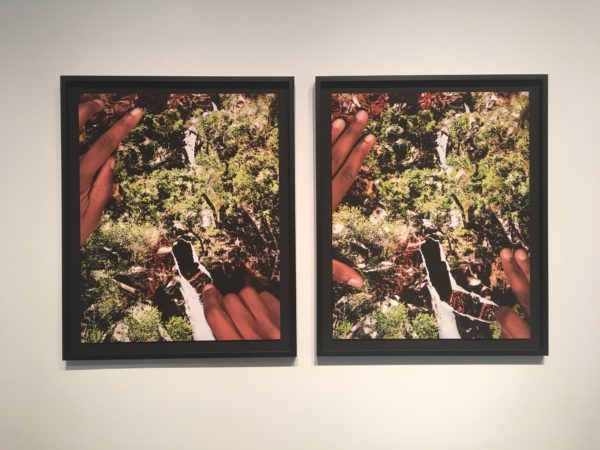From Aug. 1 to 30, the Stanford Department of Art & Art History sponsored work by Bay Area photography teachers Seth Dickerman, Dionne Lee, Aspen Mays and Lewis Watts in the McMurtry Building’s Coulter Art Gallery. The exhibition, titled “Photography Teaches: Artists from the Bay Area Academy,” was curated by assistant photography professor Jonathan Calm.
“Photographs by each artist were selected to display a sample of their respective visions, to reveal a significant connectivity–ranging from kindred sensibility to creative counterpoint–between the subjects, themes and aesthetics that interest and engage them, and to put into perspective their shared commitment to living and working in the Bay Area as a uniquely inspirational place of nature, history and community,” states the Department of Art & Art History’s exhibit overview.
Upon entering the gallery, Watts’ “New Orleans Exhibit” was clearly visible along the right wall next to the doors. The work is inspired by the Great African American Migration of the 20th Century, and Watts, a professor emeritus of art at UC Santa Cruz, picked New Orleans because of Loiusiana’s strong connection to the West Coast. Six weeks after Hurricane Katrina, Watts was able to gain access to the city and look beneath the surface of the city’s culture.
“There has been a concerted effort to make sure that the cultural practice and cultural workers endure as there has been an equally concentrated effort to keep many of the African American residents from returning after they were evacuated from the storm,” Watts wrote in an exhibit description displayed at the gallery. “I have tried to show the look, smell, and sound of New Orleans with my work.”

Lee, who received her M.F.A. from California College of the Arts in 2017, explores ideas of power, agency and racial histories in relation to the American landscape through her work in photography, collages and video. Five of her works were on display on the back wall of the gallery, with titles such as “A Plot That Also Grounds” and “a site for seeing; no other way to say we are waiting.”
“A Plot That Also Grounds” depicts a marsh-like landscape, with small pink flowers in the foreground before a small river, which is surrounded by reeds and tall grasses. Two African American hands reach into the picture, one holding a circular piece of the painting, which looks like a scrap of paper torn out of the middle of a picture. There is a black hole where the missing piece should be.
“A touchstone of my research is the history of black bodies on American soil,” Lee wrote for the Department of Art & Art History. “Traditionally presented as a refuge, a place of peak contentment and peace, the American landscape is also a place of violence and alienation.”

On the wall directly left of the gallery entrance were multiple 20-by-24-inch prints of various American coins. Dickerman, a professional fine printer since the 1970s and founder of photo lab Dickerman Prints, displays “Currency,” a collection of black and white images of presidential portraits found on U.S. coins. Of the 10 photographs in the series, three were found in the Coulter exhibition: George Washington, Abraham Lincoln and John F. Kennedy. Dickerman told the Department of Art & Art History that the seed of his project was planted in 1986, when he was “struck by the dignity” of Franklin D. Roosevelt’s portrait on a silver dime.
“The coins and bills from which these portraits were photographed are history books in disguise,” Dickerman wrote of his work in a biography available at the gallery. “They bear witness to change: physical, historical and philosophical.”
Mays, whose work was displayed further along on the left wall, received her M.F.A. in photography from the School of the Art Institute of Chicago in 2009, and uses her background in anthropology to “explore humankind’s connections with various scientific phenomena and ephemeral lifetime events,” according to the Crystal Bridges Museum of American Art.
On display at the gallery is Mays’ 2010 work “The Sun 1957,” a collection of gelatin silver prints depicting the Sun from a mid-century international survey of sunspots. The prints are assembled chronologically into a grid resembling a calendar.

After conducting research alongside astrophysicists in Chile, the home of the most advanced astronomical observatories in the world, Mays used an abandoned darkroom at the National Astronomical Observatory of Chile to make “The Sun 1957.”
“To my initial surprise, these spectacular technologies drove me instead to seek the rudimentary tools that could offer a more humble, embodied experience of observing the night sky,” Mays wrote of her inspiration for “The Sun 1957” in a description of the piece found at the gallery.
Also on display was Mays’ “Cerro Calán,” a collage made from “two found burning masks” and the lid of a box of Kodak paper. The piece is named after the hilltop on which the Chilean observatory was located.
The Coulter Art Gallery is open Tuesday through Sunday from 12 to 6 p.m.
Contact Anishi Patel at anishi.patel10 ‘at’ gmail.com.
